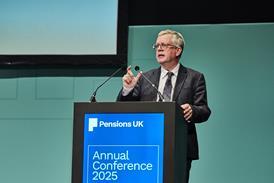Editor's blog: Labour's former shadow pensions minister Rachel Reeves, now shadow work and pensions secretary, has made the opposition's most substantial pledge yet on workplace pensions – to reduce the lower eligibility threshold from £10,000 to £5,772.
This would return the policy to its original Labour formulation of tying the lower limit to the lower earnings limit for national insurance, to bring another 1.5m people into workplace pensions.
The coalition government has instead linked in to the PAYE tax threshold, which has increased as it has taken more lower earners out of tax.
Labour hinted at reversing this in its 2012 policy paper, 'Pensions people can trust':

Source: Labour.org.uk
Speaking at the 2014 Confederation of British Industry pensions conference in January, pensions minister Steve Webb addressed the issues arising from an NI link.
This would return the policy to its original Labour formulation of tying the lower limit to the lower earnings limit for national insurance, to bring another 1.5m people into workplace pensions.
The coalition government has instead linked in to the PAYE tax threshold, which has increased as it has taken more lower earners out of tax.
Labour hinted at reversing this in its 2012 policy paper, 'Pensions people can trust':

Source: Labour.org.uk
Speaking at the 2014 Confederation of British Industry pensions conference in January, pensions minister Steve Webb addressed the issues arising from an NI link.
"Can you imagine the nonsense? You pay someone £6,000, they've got £500 above the band of earnings... on which you have to pay 1 per cent, so that's £5 a year, or 10p a week."
Bringing more people into the fold will give the savings culture the best chance to thrive
This is always going to be the weak point of the policy. Anyone that has heard the minister speak over the past few years has heard this same formulation of attack, and the contributions will be in many cases paltry.
But it is at best unhelpful and at worse irrelevant to divide pension contributions into weekly totals – that will themselves escalate – and perhaps unwise to disparage even low levels of saving.
In Labour's defence, the government has repeatedly said auto-enrolment has been designed to create a culture of saving for retirement, perhaps acknowledging that the current 8 per cent total contribution minimum will not be enough. And bringing more people into the fold will give this culture the best chance to thrive.
But the same point also demonstrates that there are more coherent, if more costly, areas where Labour could set out its stall to improve workplace saving. Which party is going to have the confidence to go into the next election arguing that contribution levels are not high enough?
Blast from the past
Interestingly, Reeves has historically stressed the importance of cross-party consensus and reform continuity, in a two-part 2011 video interview with Pensions Expert predecessor schemeXpert.com.
"If pensioners and people saving for retirement think that every time there is a change of government there is going to be changes to the rules for pension savings then I think that doesn't create the right certainty and incentives for the saving that we need people to be doing."
She said at the time of auto-enrolment: "That's going ahead in a slightly watered-down format, but it is going ahead." But the main battlegrounds Reeves was fighting on were the state pension age and the pension indexation switch between the retail price index and the consumer price index.
I wonder whether an incoming Labour government would build on these previous concerns to reverse the RPI-CPI switch, with the increase that would add back to the public sector pensions bill? Unlikely perhaps.














